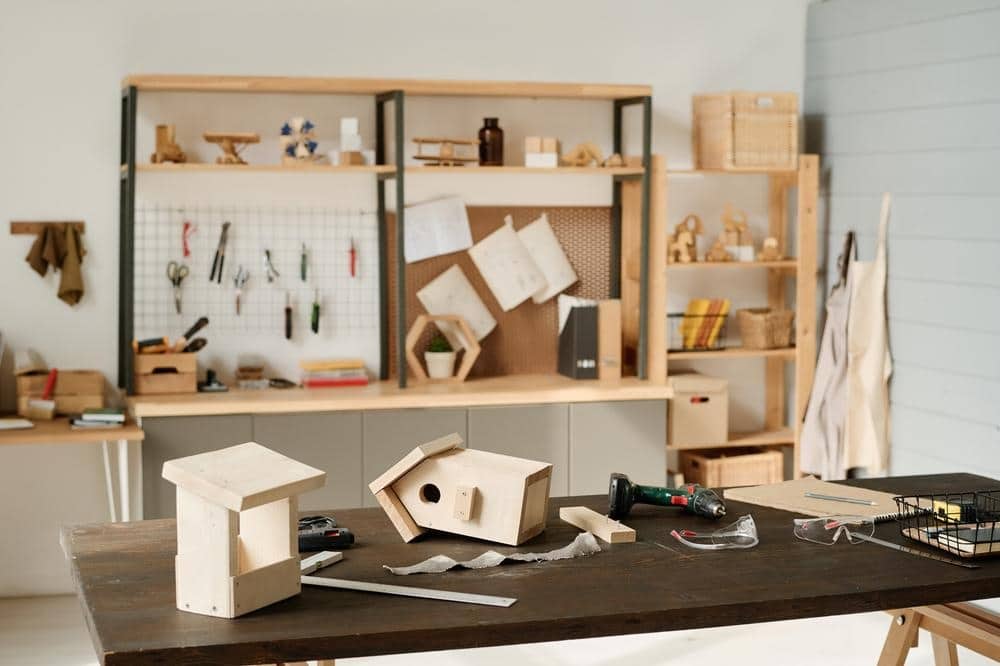Having a dedicated craft room can transform your creative practice from a scattered hobby into a focused, productive pursuit. As someone who has helped dozens of makers design their ideal workspaces, I've seen firsthand how the right setup can boost creativity, organization, and enjoyment.
Whether you're converting a spare bedroom, carving out space in a basement, or setting up a corner in your living area, this guide will walk you through creating a functional, inspiring craft room that works for your specific needs and budget.
Why a Dedicated Craft Space Matters
A well-designed craft room does more than just store your supplies—it creates an environment that supports and enhances your creative process. Here's why investing in a proper craft space pays dividends:
- Reduces setup and cleanup time, making it easier to work on projects spontaneously
- Keeps supplies organized and accessible, so you can focus on creating
- Creates mental separation between creative time and daily responsibilities
- Protects your investment in tools and materials with proper storage
- Allows you to leave projects in progress without disrupting household spaces
- Provides inspiration through a curated, personalized environment
Pro Tip
Before purchasing any furniture or storage solutions, spend time analyzing your crafting workflow. What projects do you work on most frequently? What tools do you reach for constantly? Designing around your actual habits will create a more functional space than copying generic craft room layouts.
Essential Craft Room Tools
Building a well-equipped craft room doesn't mean buying every tool available. Start with these versatile essentials that cover multiple crafting disciplines:
Power Tools for Advanced Crafters
If you work with wood, metal, or other rigid materials, these power tools expand your capabilities:
- Rotary Tool: Versatile for cutting, sanding, engraving, and polishing
- Hot Knife: Cuts and seals synthetic fabrics and foam
- Heat Gun: Essential for embossing, shrink plastic, and setting certain adhesives
- Jewelry Tools: If you make jewelry, consider a flex shaft and basic plier set
Craft Room Layout and Zones
An effective craft room is organized into functional zones based on your workflow. Here's how to plan your space:
Cutting and Measuring Zone
This area needs a large, flat surface for cutting fabric, paper, or other materials. Include your cutting mat, rulers, rotary cutters, and scissors. A counter-height table is ideal for comfortable standing work.
Lighting is Critical
Good lighting prevents eye strain and ensures accuracy. Combine overhead lighting with task lighting at each workstation. Natural light is ideal, but if that's not possible, choose full-spectrum LED bulbs that mimic daylight.
Sewing and Assembly Zone
If you sew, this area should accommodate your sewing machine, serger, and pressing station. Arrange these in a triangle for efficient workflow—sewing machine, then ironing board, then cutting table.
Creative and Design Zone
This is your inspiration station—a comfortable area for sketching, planning, and computer work. Include a comfortable chair, bulletin board for inspiration, and storage for sketchbooks and reference materials.
Storage and Supply Zone
Dedicate wall space or a specific area for organized storage. Use clear containers so you can see contents at a glance, and group similar items together.
Organization Systems That Work
The key to maintaining an organized craft room is having intuitive systems that make putting things away as easy as taking them out.
Organize by category, not by project. When supplies are grouped by type (all paints together, all ribbons together), you can easily see what you have and find what you need for any project.
-
Sort and categorize everything
Before organizing, take inventory of all your supplies. Group similar items together and purge anything you haven't used in over a year.
-
Choose the right containers
Use clear plastic bins for small items, open baskets for frequently used supplies, and labeled boxes for seasonal or specialty items.
-
Utilize vertical space
Install shelving, pegboards, and wall-mounted organizers to keep surfaces clear and supplies within easy reach.
-
Create a labeling system
Label everything clearly. Use pictures for children or visual learners. Consistent labeling makes maintaining organization much easier.
Storage Solutions by Craft Type
Different crafts require different storage approaches. Here are specialized solutions for common craft supplies:
Fabric and Textiles
Store fabric flat or rolled—never crammed in bins where it develops permanent creases. Use comic book boards to create mini bolts for smaller pieces, and install curtain rods or dowels for hanging larger pieces.
Safety First
Store hazardous materials like spray adhesives, paints, and solvents in well-ventilated areas, clearly labeled, and out of reach of children and pets. Keep a fire extinguisher in your craft room and ensure electrical cords are properly managed to prevent tripping hazards.
Paper and Cardstock
Use vertical paper organizers or filing cabinets to store paper flat and prevent curling. Sort by color, pattern, or weight depending on how you use paper most frequently.
Beads and Small Embellishments
Clear compartment boxes with adjustable dividers are ideal for beads, sequins, and small findings. Stackable versions save space and keep everything visible.
Budget-Friendly Craft Room Setup
Creating a functional craft room doesn't require a huge budget. These affordable solutions deliver maximum impact:
Inexpensive Furniture Ideas
- Kitchen tables: Look for solid wood tables at thrift stores—they're sturdy and have large work surfaces
- Bookcases: Inexpensive bookcases provide vertical storage and can be customized with baskets and bins
- Pegboard: One of the most versatile and affordable organization systems available
- Storage cubes: Modular cube systems are affordable and can be configured to fit any space
DIY Storage Solutions
Get creative with everyday items to create custom storage:
- Use tension rods inside cabinets to hold wrapping paper rolls
- Repurpose glass jars for buttons, beads, and small supplies
- Create ribbon organizers from paper towel holders or curtain rods
- Use muffin tins or egg cartons to sort small items while working
Your First Craft Room Project: Pegboard Organization Wall
A pegboard wall is one of the most versatile and affordable organization solutions you can install. This weekend project will transform your storage capabilities.
Materials Needed:
- 4' x 4' pegboard panel
- 1" x 2" lumber for framing
- Pegboard hooks and accessories
- Drywall anchors and screws
- Paint (optional)
- Level and measuring tape
-
Plan your layout
Determine what you'll store on the pegboard and sketch a rough layout. Group frequently used items at eye level and heavier items lower on the board.
-
Build a frame
Cut 1" x 2" lumber to create a frame that fits behind your pegboard. This creates space between the wall and board for hooks to lock in place.
-
Paint if desired
Prime and paint your pegboard before installation. Consider a bright color to add personality to your space.
-
Mount securely
Locate studs in your wall and mount the frame securely. Then attach the pegboard to the frame using screws.
-
Arrange accessories
Start organizing with your pegboard hooks and accessories. Leave some empty space for future needs.
Maintaining Your Craft Room
An organized craft room requires regular maintenance to stay functional. Develop these habits to keep your space working for you:
- Five-minute daily tidy: Spend five minutes at the end of each crafting session putting things away
- Seasonal purge: Every three months, evaluate your supplies and donate or discard unused items
- Project cleanup: Completely clean up between major projects to reset your space
- Inventory tracking: Keep a running list of supplies you're running low on to avoid last-minute store runs
Common Craft Room Mistakes to Avoid
Learn from these common setup errors to create a more functional space:
- Poor lighting: Insufficient lighting causes eye strain and color matching errors
- Inadequate surface space: Cramped workspaces limit what you can create
- Over-customization: Building storage for specific crafts limits flexibility as your interests evolve
- Ignoring workflow: Arranging stations without considering how you move between them creates inefficiency
- Forgetting comfort: Uncomfortable seating and improper table heights lead to physical strain
Adapting for Small Spaces
Not everyone has a dedicated room for crafting. These solutions work for compact spaces:
Closet Craft Room
Remove closet doors and install a desk across the opening. Use the interior for shelving and the desk surface for workspace. When not in use, a curtain can conceal the area.
Mobile Craft Cart
A rolling cart with essential supplies can be stored in a closet and brought out when needed. Look for models with multiple tiers and sturdy wheels.
Wall-Mounted Solutions
Fold-down tables, wall-mounted sewing machine cabinets, and magnetic knife strips for tools can create a craft space that disappears when not in use.
Final Thoughts
Creating your ideal craft room is a journey, not a destination. Start with the essentials, then let your space evolve as you discover what works best for your creative process. The most important element isn't having the perfect storage system or the most expensive tools—it's creating an environment that inspires you to create regularly.
Remember that your craft room should reflect your personality and working style. Don't be afraid to break conventional design rules if something works better for you. The best craft room is the one that you actually use and enjoy spending time in.
Whether you're setting up a expansive dedicated space or carving out a creative corner, these principles will help you build a functional, inspiring craft room that supports your creative journey for years to come. Happy crafting!

